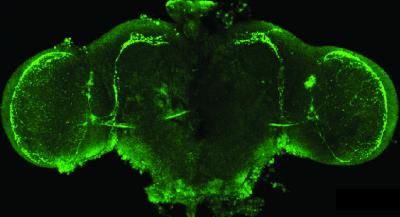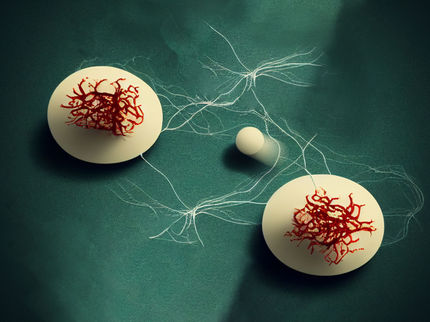Scientists watch live brain cell circuits spark and fire
NIH-funded scientists show new genetically engineered proteins may be important tool for the President's BRAIN Initiative
Scientists used fruit flies to show for the first time that a new class of genetically engineered proteins can be used to watch nerve cell electrical activity in live brains. The results, published in Cell, suggest these proteins may be a promising new tool for mapping brain cell activity in multiple animals and for studying how neurological disorders disrupt normal nerve cell signaling.

Scientists used a new protein, called ArcLight, to watch nerve cell electricity in a live fly brain.
Courtesy of Nitabach & Pieribone Labs, Yale School of Medicine, New Haven, CT
Brain cells use electricity to control thoughts, movements and senses. Ever since the late nineteenth century, when Dr. Luigi Galvani induced frog legs to move with electric shocks, scientists have been trying to watch nerve cell electricity to understand how it is involved in these actions. Usually they directly monitor electricity with cumbersome electrodes or toxic voltage-sensitive dyes, or indirectly with calcium detectors. This study, led by Michael Nitabach, Ph.D., J.D., and Vincent Pieribone, Ph.D., at the Yale School of Medicine, New Haven, CT, shows that a class of proteins, called genetically encoded fluorescent voltage indicators (GEVIs), may allow researchers to watch nerve cell electricity in a live animal.
Dr. Pieribone and his colleagues developed ArcLight, the protein used in this study. ArcLight fluoresces, or glows, as a nerve cell's voltage changes and enables researchers to watch, in real time, the cell's electrical activity. In this study, Dr. Nitabach and his colleagues engineered fruit flies to express ArcLight in brain cells that control the fly's sleeping cycle or sense of smell. Initial experiments in which the researchers simultaneously watched brain cell electricity with a microscope and recorded voltage with electrodes showed that ArcLight can accurately monitor electricity in a living brain. Further experiments showed that ArcLight illuminated electricity in parts of the brain that were previously inaccessible using other techniques. Finally, ArcLight allowed the researchers to watch brain cells spark and fire while the flies were awakening and smelling. These results suggest that in the future neuroscientists may be able to use ArcLight and similar GEVIs in a variety of ways to map brain cell circuit activity in normal and disease states.
Original publication
Other news from the department science

Get the life science industry in your inbox
By submitting this form you agree that LUMITOS AG will send you the newsletter(s) selected above by email. Your data will not be passed on to third parties. Your data will be stored and processed in accordance with our data protection regulations. LUMITOS may contact you by email for the purpose of advertising or market and opinion surveys. You can revoke your consent at any time without giving reasons to LUMITOS AG, Ernst-Augustin-Str. 2, 12489 Berlin, Germany or by e-mail at revoke@lumitos.com with effect for the future. In addition, each email contains a link to unsubscribe from the corresponding newsletter.





















































